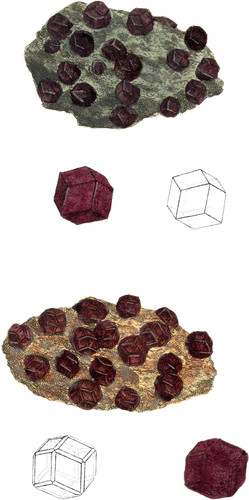 Enlarge
Enlarge
British Mineralogy
Garnet
- Class 2. Earths.
- Order 1. Homogeneous.
- Gen. 6. Silex.
- Spec. 13? Garnet.
- Div. 1. Crystallized.
- Var. 1. dodecaëdral, or primitive.
- Gen. Char. Primitive form, the rhomboidal dodecaëdron; scratches quartz.
- Syn.
- Garnet. Kirw. 1. 258.
- Granat. Emmerl. 1. 43, and 3. 246.
- Borax granatus. Linn Syst. ed. 13. v. 4. p. 96.
- Grenat. Haüy, 2. 540.
Garnets are of different degrees of hardness. The Oriental and Bohemian ones are of a brighter colour, and are much harder than the British, but all want the aid of the lapidary by thinning them, to show their lustre, and when set by the jewellers are always placed upon a foil. They were much esteemed for hoop-rings, ear-rings, &c. about 40 years ago. The British garnets are commonly much the softest, and not valued by the lapidaries. They are chiefly found inclosed in micaceous and granite rocks, though sometimes otherwise. Besides the other ingredients spoken of in garnets, the British ones frequenly hold particles of mica, and are of a less firm texture. We, however, have the satisfaction to find them present most of the different forms of crystallization. We here give a representation of what is reckoned the primitive crystal, (viz.) the rhomboial dodecaëdron. These are found in great plenty in the Plum-pudding rocks, as they are called, at Huntly in Scotland. We have bought specimens at sales which are said to come from Bohemia, seemingly of the same sort, and in the same gangue as those from Huntly. The Syrian garnet is of a more scarlet hue, though I have some cut ones, said to come from Scotland, nearly of the same colour, but rather less bright.
The lower figures are from rocks near the same place in a lighter-coloured gangue (a granite), with the edges of the dodecaëdron forming 24 narrow hexaëdral facets, in addition to the 12 rhomboidal faces. I have the same sort of garnet, though lighter, in a basaltic stone, and in greenish hornstone from Scotland. Mr. Jameson has found them in micaceous schistus, v. 1. 219. v. 2. 212. External lustre casual, internal 2.3.1. of the brownish and blackish frequently 0. Kirw. Fracture of the hard ones somewhat flinty or conchoidal. Mr. Kirwan calls the oriental garnets carbuncles, p. 258.

